
КАТЕГОРИИ:
Архитектура-(3434)Астрономия-(809)Биология-(7483)Биотехнологии-(1457)Военное дело-(14632)Высокие технологии-(1363)География-(913)Геология-(1438)Государство-(451)Демография-(1065)Дом-(47672)Журналистика и СМИ-(912)Изобретательство-(14524)Иностранные языки-(4268)Информатика-(17799)Искусство-(1338)История-(13644)Компьютеры-(11121)Косметика-(55)Кулинария-(373)Культура-(8427)Лингвистика-(374)Литература-(1642)Маркетинг-(23702)Математика-(16968)Машиностроение-(1700)Медицина-(12668)Менеджмент-(24684)Механика-(15423)Науковедение-(506)Образование-(11852)Охрана труда-(3308)Педагогика-(5571)Полиграфия-(1312)Политика-(7869)Право-(5454)Приборостроение-(1369)Программирование-(2801)Производство-(97182)Промышленность-(8706)Психология-(18388)Религия-(3217)Связь-(10668)Сельское хозяйство-(299)Социология-(6455)Спорт-(42831)Строительство-(4793)Торговля-(5050)Транспорт-(2929)Туризм-(1568)Физика-(3942)Философия-(17015)Финансы-(26596)Химия-(22929)Экология-(12095)Экономика-(9961)Электроника-(8441)Электротехника-(4623)Энергетика-(12629)Юриспруденция-(1492)Ядерная техника-(1748)
What your score means
|
|
|
|
20 or less: Your health and your life are in danger! You must do more exercises.
21-30: Could be worse, but not much worse.
31-40: Not bad, but could be better.
41-50: You are healthier than the average person and you probably find your life more enjoyable as a result.
51 or more: You are super-fit. Are you a professional athlete? (Or are you a liar!)
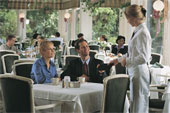
|
| AT THE RESTAURANT | В РЕСТОРАНІ |
| Table d’hote items | Чергові страви |
| A la carte items | Порційні страви |
| Ethnic food | Національні страви |
| Drinks | Напої |
| Dressing | Приправи |
| To go Dutch | Платити кожен за себе |
| 1. I am hungry (thirsty). | 1. Я зголоднів (хочу пити). |
| 2. I want to eat (drink). | 2. Я хочу їсти (пити). |
| 3. Where are we going for dinner? | 3. Куди підемо обідати? |
| 4. Where can I get… - a quick snack - an inexpensive meal | 4. Де я можу… - швидко перекусити - недорого поїсти |
| 5. Let’s go to Mc Donald’s. | 5. Давайте підемо у Мак Дональдс. |
| 6. Let’s have breakfast (lunch, dinner) at a restaurant. | 6. Давайте поснідаємо (пообідаємо) в ресторані. |
| 7. I would like to sit… - further from the band - in the corner - by the window | 7. Я хотів би сісти… -подальше від оркестру - в кутку - біля вікна |
| 8. Menu, please. | 8. Меню, будь-ласка. |
| 9. What are today’s specials? | 9. Що ви сьогодні пропонуєте у меню? |
| 10. What do you recommend… - for a cold (hot) appetizers - the main course - meat (fish) dish - dessert | 10. Що б ви порекомендували … - з холодних (гарячих) закусок - на друге - з м’яса (риби) - на десерт |
| 11. Please, call the waiter (head waiter). | 11. Покличте офіціанта (метрдотеля). |
| 12. I would like to try - some salad - a hot dish - fruit and vegetables - some orange juice - some meat (beef, pork, veal) - fish - chicken - something substantial | 12. Я б хотів взяти - салат - щось гаряче - фрукти і овочі - апельсиновий сік - м’ясо (говядину, свинину, телятину) - рибу - курку - щось суттєве |
| 13. What is your favourite dish? | 13. Яка ваша улюблена страва? |
| 14. My favorite dish is - fried chicken - roast potatoes | 14. Моя улюблена страва - смажена курка - смажена картопля |
| 15. I stick to a diet of vegetables. | 15. Я дотримуюсь овочевої дієти. |
| 16. Can I order a pizza to go? | 16. Чи можу я замовити піцу з собою? |
| 17. I prefer to eat at home. | 17. Я люблю їсти вдома. |
| 18. Pass me …., please. - the salt - the pepper - the bread - the ketchup | 18. Передайте…… - сіль - перець - хліб - кетчуп |
| 19. Is the place free? | 19. Біля Вас вільно? |
| 20. Bring me…, please. - a bottle of vine - a bottle of mineral water - a cup of tea | 20. Принесіть…. - пляшку вина - пляшку мінеральної води - чашку чаю |
| 21. Will you take our order? | 21. Будь ласка, прийміть замовлення. |
| 22. How much do I owe you? | 22. Скільки з мене? |
| 23. I didn’t order this. | 23. Я не замовляв цього |
| 24. Check, please. | 24. Рахунок, будь ласка |
| 25. Thank you for your excellent service. | 25. Дякую за відмінне обслуговування. |
| Key words:restaurant, coffee-shops, fast food, hungry, thirsty, breakfast, lunch, dinner, supper, waiter, waitress, head waiter, main course, order, cuisine, fixed price menu, snack-bars, drinks, dressing, quick snack, customer, knives, forks, spoons, plates, eating out, delicious |
| TYPES OF RESTAURANTS |
There are eight different types of places where people can eat and drink. They are very luxurious restaurants, formal luxury restaurants, informal restaurants, serving national dishes, coffee-shops, snack-bars, fast-food restaurants, bars and night clubs.
At the very luxurious restaurants dinner is à le carte. Such restaurants are usually famous for their haute cuisine. They have a sophisticated atmosphere. Their service is impeccable.
At the formal luxury restaurants the surroundings are elegant and cuisine is superb. They are appropriate for business lunches and romantic dinners.
The informal restaurants serve typical local dishes. They offer a lot of home-made dishes. They make bread and pasta themselves. These restaurants have two sorts of dinner menu: à le carte and a three-course fixed price menu. The atmosphere is cozy and relaxed and the meals are reasonably priced there.
>
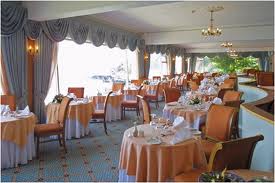
|
The fast-food restaurants offer a very quick counter service. The choice of food and drinks is fixed but limited. Such places provide a drive-in and take-out service.
The bars offer different kinds of drinks, mixed drinks, beer, juices, soda. They can also serve nuts and chips biscuits to go with the drinks.
At the night clubs the customers can have excellent wine and delicious dishes and dance to a band. Such places have a floor show. The customers can gamble if they like. They are very expensive but provide overnight catering and entertainment until 4 a.m. as a rule.
1. What are the eight different types of places where people can eat and drink?
2. What kind of places are the very luxurious and the formal luxury restaurants?
3. What kind of places are the coffee-shop and the snack-bars?
4. What kind of places are the bars?
5. What kind of places are the night clubs?
6. What kind of restaurants are there in your town?
7. Where do you prefer to eat and drink?
8. What makes a good restaurant?
| MEALS IN BRITAIN |
The names of meals in Great Britain are: breakfast, lunch, dinner and supper. Breakfast in the morning may be corn flakes, taken with milk and sugar, bacon or ham with or without eggs, or some kind of fish. Toast of bread and butter with marmalade and a cup of tea or
Some people just have toast, butter and cheese with tea or coffee for breakfast. English people usually drink tea with milk and this tea is called “English tea.”
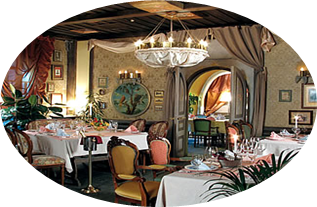
|
For dinner there’s always a main dish, consisting usually of meat or fish with potatoes and cooked vegetables.
Lunch or supper is a lighter meal. Many families living in the north eat something like bread and butter with perhaps fried eggs or fried fish and tea in the evening.
Another purely British institution is High tea. It is rather a heavy meal with tea, instead of late dinner. In the past it was more the custom to have something cold for high tea and something hot for supper. Nowadays foods for high tea and supper are interchangeable.
Fish and chips, very popular with the English and the visitors to the British Isles, are pieces of fish (cold, plaice) boiled in oil taken with small pieces of fried potatoes. Both the fish and the potatoes should be crisp on the outside and soft inside.
And finally, there is British marmalade, which is an important part of the English breakfast. It is made from oranges or any other citrus fruits. Grape fruits and lemons make a sweeter marmalade for tea-time.
 Pudding is one of the traditional English food.
Pudding is one of the traditional English food.
 Christmas pudding is made from fruit only.
Christmas pudding is made from fruit only.
 Custard is eaten with meat.
Custard is eaten with meat.
 High tea is rather a heavy meal with tea.
High tea is rather a heavy meal with tea.
 Fish and chips are raw pieces of fish and potatoes.
Fish and chips are raw pieces of fish and potatoes.
 British marmalade is made from oranges or other citrus fruit.
British marmalade is made from oranges or other citrus fruit.
1. What does the Christmas pudding look like? What products is it made from?
2. What is “custard”?
3. Are foods for high tea and supper interchangeable?
4. How do they cook fish and chips?
5. What is British marmalade made from?
| EATING PLACES IN THE USA |
There are a variety of places to eat in the United States. Americans especially love fast food restaurants such as McDonald’s, Burger King, Dairy Queen, Pizza Hut, Kentucky Fried Chickens, etc. These restaurants offer a variety of cheap, fast and tasty food. Prices range from $1.00 for a main dish to $ 3.50 for an entree meal. Customers may order and eat inside the restaurant, or order food from their car at a drive-through window and take it home to eat.
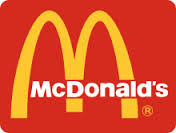
|
Ordering food is simple and pleasant process. A waiter will approach you a table with menu that he will give you to look at. He will tell you what the specialty is in detail. In a few minutes he will return to take your order. Choosing a dish can be a problem because of the variety of foods and their unfamiliar names. Ask the waiter to help you. Drinks are ordered first, then the main dish. The wait to receive your main dish is usually 10-20 minutes. Drinks and appetizers are brought immediately. Don’t let the number of knives, forks and spoons confuse you. Use them in the order they are set starting with the farthest ones from your plate.
The check is paid at the front cash register, or taken by the waiter, depending on the restaurant. A tip of 15% of the check should be left on the table for the waiter. Don’t say anything about the tip, just leave it on the table.
Most Americans like fruit salads, ice-cream, vegetables, beef, potatoes, ethnic food, hamburgers, hot dogs, Chinese food, spaghetti, pizza, sea food.
They don’t like fat meat, cabbage as a garnish or liver.
A special note:
· all drinks and water should be served with ice;
· serve cream separately;
· coffee is much more common than tea. Typical American coffee is usually very weak. The best varieties of coffee are Cappuccino, Espresso, Cafe Mocha, and cafe Vienna;
· salads are very popular in the United States.
AMERICAN TABLE MANNERS
1. Do not attach undue attention to yourself in public.
2. When eating take as much as you want, but eat as much as you take.
3. Do not eat too fast or too slowly, don’t chomp while eating.
4. Don’t speak with your mouth full.
5. Take a little of every dish that is offered to you.
6. Do not reach across the table. If something is in the other side of the table, say “Would you please pass the salt (bread, etc.)?”
7. Do not start eating until everyone is served unless the hostess says “Start eating, please, your food might get cold.”
8. When refusing a dish say “No, thank you.”
9. When accepting a dish say “Yes, please.”
10. If you want some more of a dish say “May I have some more meat (fish, salad, cake, etc.”
11. Do not leave the spoon in your cup when drinking tea or coffee. Put it on a special stand or on the saucer.
12. Eat cakes with forks, not spoons.
13. Don’t gulp your drink. (As soon as your glass is empty it will be promptly refilled). Sip your drink.
14. To indicate that you have finished place knife and fork on the plate together, not criss-crossed.
15.
| IN THE LUNCH HOUR (MEALS) |
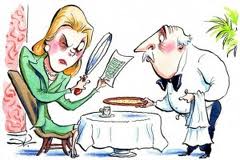
|
When we went to the canteen, there weren’t many people there. We got tickets or checks for lunch, sat down at the table near the window, and called the waitress. She brought knives, forks, spoons and plates and took our tickets.
“Will you have any soup today?” I asked Nick.
“No, I’m not very hungry,” he said. “But I’ll have some mineral water, salad, meat and potatoes, and ice-cream for sweet.”
“Oh, here is the waitress.”
(The waitress brought the dishes.)
“The salad is very good, but there is not enough salt in it. Will you pass me the salt, please?”
“Certainly. Here it is.”
“Thank you.”
“Shall I pass you some rye bread?”
“No, thank you. I usually have it with the soup, and I like white bread for the meat course”.
The waitress came up to us in a few minutes and asked if we would have coffee, or tea.
“Yes, please. Tea for my friend and coffee for me,” I said.
“Black or white?”
“Black and some cake, please.”
“How do you like your tea? She asked my friend.
“Not very strong,” he answered, and only two lumps of sugar, please.”
We talked a little, when lunch was over, and at twenty five to one went back to the office. We had a little time before work to read the newspaper and have a smoke. We began work again half an hour later.
1. I only had a cup of tea for dinner yesterday.
2. I don’t like having lunch alone.
3. The waitress brought knives, forks, spoons and plates and took our tickets.
4. Nick would like have some mineral water, salad, and ice-cream for sweet.
5. Nick likes ray bread for the meat course”.
6. They ordered not very strong tea and white coffee.
7. At twenty five past one the friends went back to the office.
8. They had a little time before work to read the newspaper and have a smoke.
| THE STORY OF "MCDONALD'S" AND "COCA-COLA" |
In 1937 the Mc Donnald brothers, Dick and Mark, opened little restaurant in California. They served hot dogs and milk shakes. In 1945 they have 20 waiters. All the teenagers in town ate hamburgers there. When the 1948 year came they got paper boxes and bags for the hamburgers. They put the price down from 30 to 15 cents. There were no more waiters — it was self-service. So it was cheaper and faster.
In 1960s the McDonald's company opened hundreds of McDonald's restaurants all over the States. In 1971 they opened restaurants in Japan, Germany and Australia.
Now the McDonald's company opens a new restaurant every 8 hours. There are more than 14,000 restaurants in over 70 countries. The Coca-Cola story began in Atlanta in 1886. John Pemberton invented a new drink. Two of the ingredients were the South American coca leaf and the African cola nut. Pemberton couldn't think of a good name for the drink. Finally, Dr. Pemberton's partner Frank Robinson suggested the name Coca-Cola. Thirty years later the famous Coca-Cola bottle design first appeared.
For many years only Coca-Cola was made. They only introduced new drinks — Fanta, Sprite in the 1960s. The recipe of Coca-Cola is a secret. Today they sell Coca-Cola in 195countries. Hundreds of millions of people from Boston to Beijing drink it every day. It has the most famous trademark in the world.
1. In 1937 the Mc Donnald brothers, Dick and Mike, opened little restaurant in California.
2. They put the price down from 30 to 25 cents.
3. In 1971 the Mc Donnald brothers opened restaurants in Japan, Germany and Australia.
4. The Coca-Cola story began in Atlanta in 1886.
5. Two of the ingredients were the North American coca leaf and the African cola nut.
6. The recipe of Coca-Cola is a secret.
7. Today they sell Coca-Cola in 195countries.
| UKRAINIAN DIET |
Living in Ukraine one cannot but stick to a Ukrainian diet. Keeping to this diet for an average Englishman may be fatal. One can easily come to this idea after experiencing a few meals in Ukraine. We traditionally have meals four times a day and our cuisine is quite intricate.
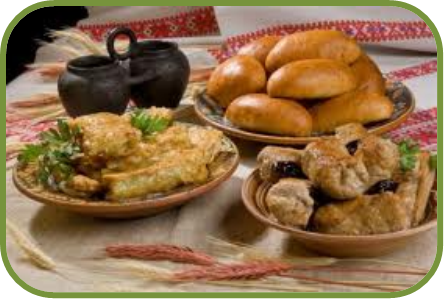 Every person starts his or her day with breakfast. Poor Englishmen are sentenced to either a continental or an English breakfast. From the Ukrainian point of view, when one has it continental it actually means that one has no breakfast at all, because it involves drinking a cup of coffee and eating a bun. A month of continental breakfast for some Ukrainians would mean starving. The English breakfast is a bit better, as it consists of fried eggs, grilled sausages, bacon, tomatoes and mushrooms. As a choice one may have corn flakes with milk and sugar or porridge. And of course a cup of tea with milk and toast with butter and marmalade. Tea is a special subject to be mentioned while speaking about the English diet. It is common knowledge that tea is a British national drink. The trouble with this drink is that originally it was quite a good drink. But a group of the most eminent British people put their heads together and suggested that one should not drink it clear, or with lemon, or rum and sugar, but pour a few drops of cold milk into it and no sugar at all, the desired object is achieved – once this refreshing, aromatic, oriental beverage is successfully transformed into colourless and tasteless gargling water which suddenly becomes a national drink of Great Britain still retaining the high-sounding title of tea.
Every person starts his or her day with breakfast. Poor Englishmen are sentenced to either a continental or an English breakfast. From the Ukrainian point of view, when one has it continental it actually means that one has no breakfast at all, because it involves drinking a cup of coffee and eating a bun. A month of continental breakfast for some Ukrainians would mean starving. The English breakfast is a bit better, as it consists of fried eggs, grilled sausages, bacon, tomatoes and mushrooms. As a choice one may have corn flakes with milk and sugar or porridge. And of course a cup of tea with milk and toast with butter and marmalade. Tea is a special subject to be mentioned while speaking about the English diet. It is common knowledge that tea is a British national drink. The trouble with this drink is that originally it was quite a good drink. But a group of the most eminent British people put their heads together and suggested that one should not drink it clear, or with lemon, or rum and sugar, but pour a few drops of cold milk into it and no sugar at all, the desired object is achieved – once this refreshing, aromatic, oriental beverage is successfully transformed into colourless and tasteless gargling water which suddenly becomes a national drink of Great Britain still retaining the high-sounding title of tea.
Yes, the English drink a lot of tea and if you are invited to their homes you should never refuse any additional cups of tea under any circumstances: if it is cold, if it is hot, if you are tired, if anybody thinks that you might be tired, if you are on edge, if you are over the moon, before you go out, if you are out, if you have just returned home, if you crave for it, if you loathe it, if you have had no tea for some time, if you have just had a cup.
In Ukraine we also drink tea for breakfast but without milk, usually black or green, occasionally herbal, but having tea often doesn’t mean “ having tea” in the British sense. In addition to it we may have anything: fried and scrambled eggs, buns, croissants and pancakes, pastries and cakes, as well as potatoes and pasta. Some good-humoured individuals even prefer soup, but, of course, sandwiches and tea or coffee are very popular.
One can easily understand that in Great Britain by one o’clock people are very much ready for lunch. Lunch is the biggest meal of the day. That would be music to Ukrainian ears until he or she learns what lunch really consists of. It may be a meat or fish course with soft drinks followed by a sweet course.
The heart of the Ukrainian person fills with joy when the hands of the clock approach 2 p.m. Our dinner differs from the British and includes three courses. We may have a salad, herring, cheese and so on for a starter, soups of various kinds for the first course, and for the second course steaks, chops, or fish fillets with the garnish of jacket, boiled, fried, mashed potatoes, spaghetti or noodles, rice or buckwheat, a lot of bread, of course, and something to drink. The more the better. At four or five the Ukrainians may have a bite: waffles, cakes with juice, tea, cocoa and stuff like this.
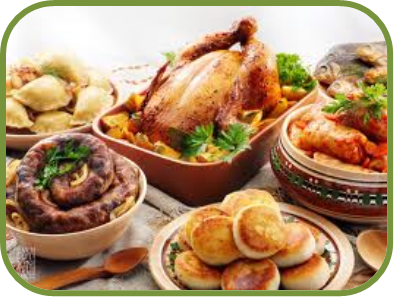 In Great Britain they have dinner at five or six. Soup may be served then, but one should not be misled by the word “soup”. British soup is just a thin paste and a portion is three times smaller than in Ukraine.
In Great Britain they have dinner at five or six. Soup may be served then, but one should not be misled by the word “soup”. British soup is just a thin paste and a portion is three times smaller than in Ukraine.
A lot of British prefer to eat out. “Fish and Chips” shops are very popular for their take-away food. No matter where you live there will be a traditional fish and chips shop within easy walking distance. The fish is usually cod, but there is also sturgeon, salmon and hake to choose from. The more sophisticated public goes to Chinese, Italian seafood or other restaurants and experiments with shrimp, inedible vegetables and hot drinks. Supper in Ukraine means one more big meal at about seven.
The table groans with food again. One can confidently say that eating never stops here. An Englishman being used to moderate portions of food finds himself unable to consume “Ukrainian” portions when invited to dinner in any place in Ukraine. Most Ukrainians have never counted calories and they are deeply convinced that their food is healthy. Some housewives may admit that it takes some time to prepare all the stuff, including pickles, home-made preserves and traditional Ukrainian varenyky, pies and pancakes. But they don’t seem to mind too much and boil, fry, roast, grill, bake and make.
The first time foreigners come to Ukraine, they prepare themselves for what they imagined to be a culinary wasteland. Brought up on old images of endless food lines, one expects the Ukrainian cuisine to be unpalatably bland and poor. But this is definitely wrong. Getting off the plane one is bound to be greeted with a “ three-course meal ” of Ukrainian borshch, roasted meat, and delicate cheese-and-jam pancakes, a number of salads followed by a great variety and numbers of other dishes. Mind you cannot refuse from a second helping under any circumstances since your refusal will be taken as a personal offence. From that moment a foreigner is stunned to discover that eating really never stops in Ukraine.
Paraphrasing a famous proverb one can say: “What is a Ukrainian man’s meat is a British man’s poison”.
|
|
|
|
|
Дата добавления: 2014-11-29; Просмотров: 1219; Нарушение авторских прав?; Мы поможем в написании вашей работы!